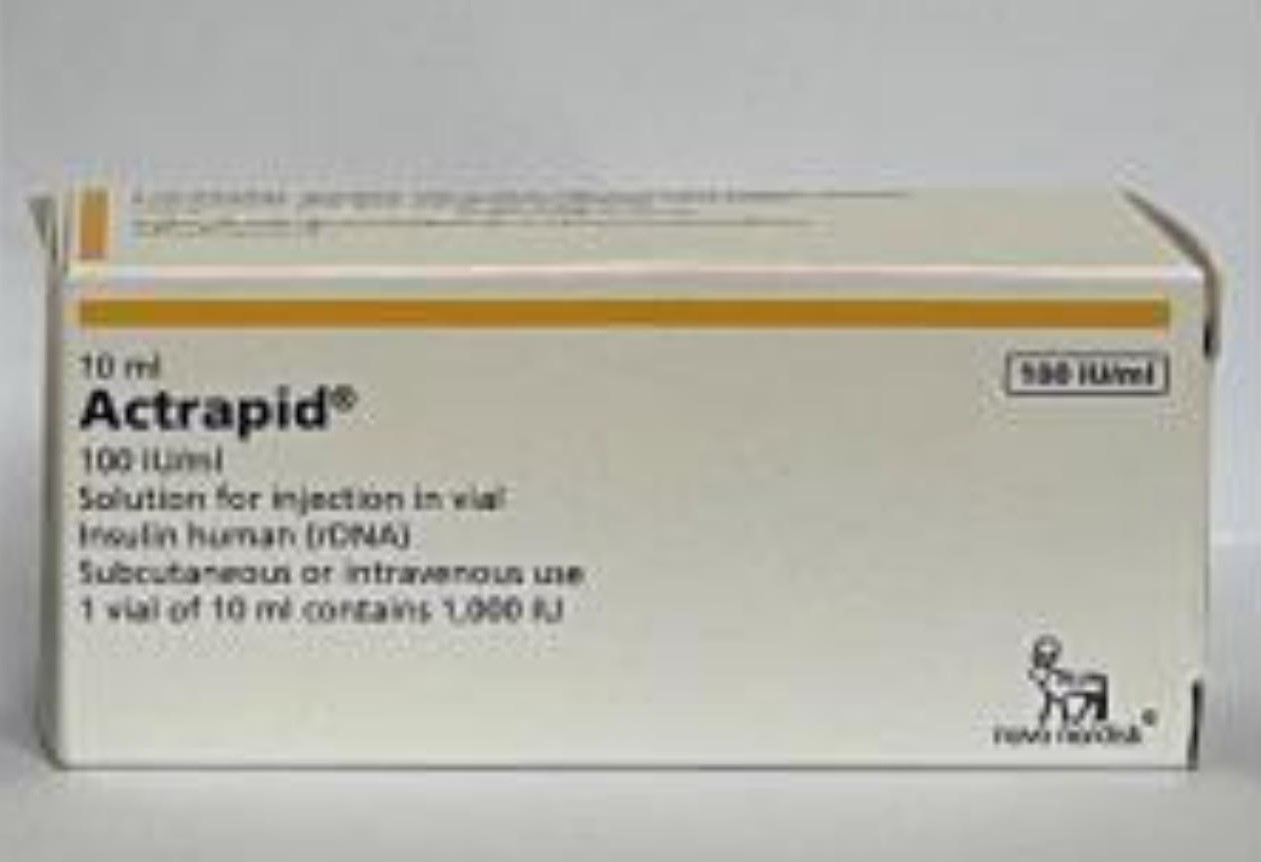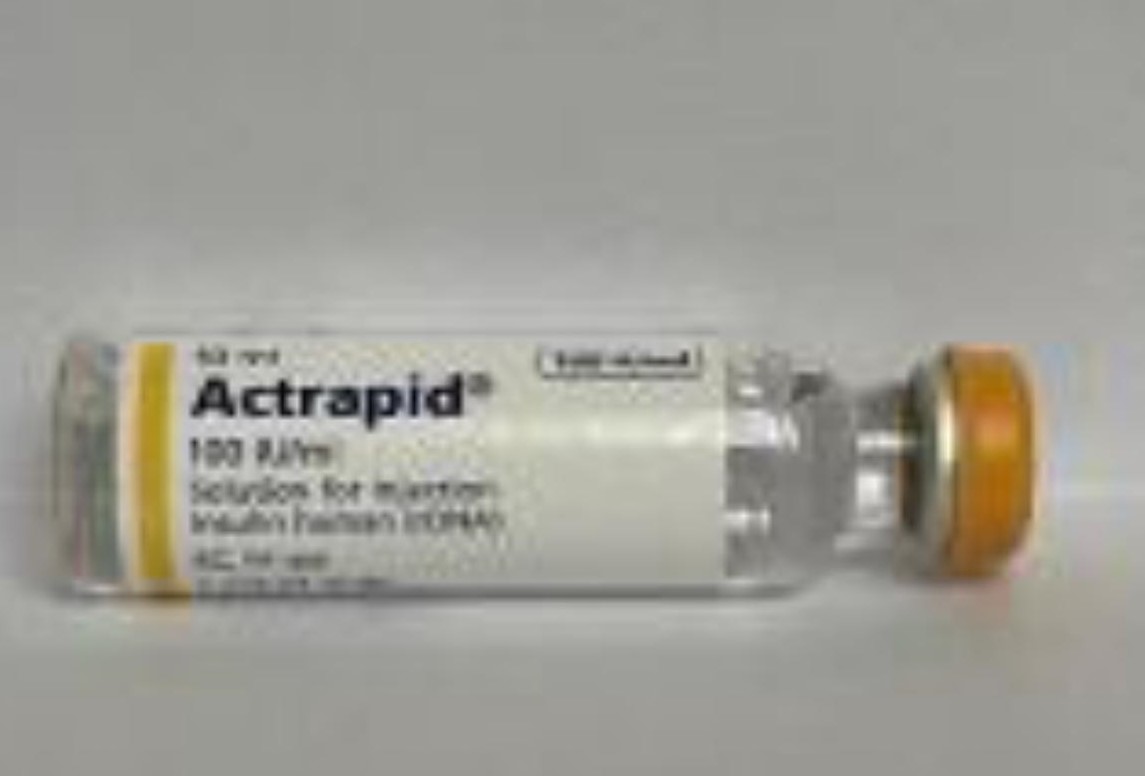Drug information
Regular insulin (Soluble insulin sterile solution 100 iu/1mL) (ACTRAPID) 10 mL Click to listen highlighted text! Regular insulin (Soluble insulin sterile solution 100 iu/1mL) (ACTRAPID) 10 mL


Indications
Reduce blood sugar level. Click to listen highlighted text! Indications Reduce blood sugar level.
Contraindications and precautions
Do not use if you had an allergic reaction to medication or its components. Click to listen highlighted text! Contraindications and precautions Do not use if you had an allergic reaction to medication or its components.
How to Inject Insulin with a Syringe.
1.Wash your hands with soap and water. Dry your hands.
2.Remove the vial from the refrigerator. Roll the vial between your palms gently in order that insulin appears homogeneous, not separated and close to body temperature which helps reduce pain after injection.
3.Take the cover off the insulin vial. Wipe rubber top of the insulin vial with a cotton ball dipped in alcohol.
4.Pull back the plunger of the syringe, drawing air into the syringe equal to the dose of insulin that you want to take.
5.Put the syringe needle through the rubber top of the insulin vial. Inject air into the vial.
6. Turn the vial upside down and make sure that the tip of the needle is in insulin. Pull back on the syringe plunger to draw the correct dose of insulin into the syringe.
(Make sure there are no air bubbles in the syringe before you take the needle out of the insulin vial. If there are air bubbles, push syringe to release the bubbles back into the vial.)
7.Clean your skin with cotton ball dipped in alcohol.
8.Use a hand to pinch the skin. Use another hand to hold the syringe like a pen then inject insulin with the needle at an angle of about 45-90 degrees. Push the syringe plunger forward to inject insulin slowly.
9.Withdraw the needle from the skin. Press the injection site gently with a cotton ball dipped in alcohol. You should not roll or rub down the injection site. Click to listen highlighted text! How to Inject Insulin with a Syringe. 1.Wash your hands with soap and water. Dry your hands. 2.Remove the vial from the refrigerator. Roll the vial between your palms gently in order that insulin appears homogeneous, not separated and close to body temperature which helps reduce pain after injection. 3.Take the cover off the insulin vial. Wipe rubber top of the insulin vial with a cotton ball dipped in alcohol. 4.Pull back the plunger of the syringe, drawing air into the syringe equal to the dose of insulin that you want to take. 5.Put the syringe needle through the rubber top of the insulin vial. Inject air into the vial. 6. Turn the vial upside down and make sure that the tip of the needle is in insulin. Pull back on the syringe plunger to draw the correct dose of insulin into the syringe. (Make sure there are no air bubbles in the syringe before you take the needle out of the insulin vial. If there are air bubbles, push syringe to release the bubbles back into the vial.) 7.Clean your skin with cotton ball dipped in alcohol. 8.Use a hand to pinch the skin. Use another hand to hold the syringe like a pen then inject insulin with the needle at an angle of about 45-90 degrees. Push the syringe plunger forward to inject insulin slowly. 9.Withdraw the needle from the skin. Press the injection site gently with a cotton ball dipped in alcohol. You should not roll or rub down the injection site.
NOTE
-The places to give yourself an injection are abdomen (the best), except for a 1-inch area right around the navel, thighs, upper arms, upper outer area of the buttocks.
- The injection site should be rotated frequently. The drug should be injected beside the prior injection site for 1 inch.
- If the symptoms of low blood sugar occur such as palpitation, tremor, sweating, fainting, etc, you have to eat candy or sweet drink immediately. If you don't feel better within 15-30 minutes, you should see a doctor immediately.
- Injection devices should not be shared with others.
-The drug should be injected not more than 5-15 minutes before meals.
- Checking the dose as directed by your doctor prior to injection. Do not use more or less than instructed by your doctor as it may cause side effects.
-You should put the pen cap back on your device and dispose it in the container with the cover.
- If the Insulin is separated, it should be resuspend until it appears homogeneous before use by rolling the cartridge or moving it up and down with your wrist slowly. Do not shake as it may result in drug deterioration. Click to listen highlighted text! NOTE -The places to give yourself an injection are abdomen (the best), except for a 1-inch area right around the navel, thighs, upper arms, upper outer area of the buttocks. - The injection site should be rotated frequently. The drug should be injected beside the prior injection site for 1 inch. - If the symptoms of low blood sugar occur such as palpitation, tremor, sweating, fainting, etc, you have to eat candy or sweet drink immediately. If you dont feel better within 15-30 minutes, you should see a doctor immediately. - Injection devices should not be shared with others. -The drug should be injected not more than 5-15 minutes before meals. - Checking the dose as directed by your doctor prior to injection. Do not use more or less than instructed by your doctor as it may cause side effects. -You should put the pen cap back on your device and dispose it in the container with the cover. - If the Insulin is separated, it should be resuspend until it appears homogeneous before use by rolling the cartridge or moving it up and down with your wrist slowly. Do not shake as it may result in drug deterioration.
Adverse Reactions
This medicine may cause low blood sugar, pain at injection site, dimple or bruising at injection site, allergic rash, itching. Click to listen highlighted text! Adverse Reactions This medicine may cause low blood sugar, pain at injection site, dimple or bruising at injection site, allergic rash, itching.
Drug storage
1.The vial must be stored in the refrigerator (2-8 degree Celsius), not in a refrigerator door or under freezing compartment. Do not freeze.
2.The expiry date of the vial that is not being used is stated on the vial's label. For the vial that is being used, insulin is valid for 1 month. Click to listen highlighted text! Drug storage 1.The vial must be stored in the refrigerator (2-8 degree Celsius), not in a refrigerator door or under freezing compartment. Do not freeze. 2.The expiry date of the vial that is not being used is stated on the vials label. For the vial that is being used, insulin is valid for 1 month.
The above information is drug information used for patient self-care only.
If you have any inquiries, please ask your physicians or pharmacists. Click to listen highlighted text! The above information is drug information used for patient self-care only. If you have any inquiries, please ask your physicians or pharmacists.
ที่มาของข้อมูล:
1.สุชาดา ชุติมาวรพันธ์, โพยม วงศ์ภูวรักษ์, อภิฤดี เหมะจุฑา, ฐิติมา ด้วงเงิน, กิติยศ ยศสมบัติ, บรรณาธิการ. คู่มือทักษะตามเกณฑ์ความรู้ความสามารถทางวิชาชีพของผู้ประกอบวิชาชีพเภสัชกรรม (สมรรถนะร่วม) พ.ศ. 2562. นนทบุรี: บริษัท เอช อาร์ พริ้นซ์ แอนด์ เทรนนิ่ง จำกัด ; 2562
2.Micromedex® [Database on internet]. Colorado: Thomson Reuters (Healthcare); c2020. Available from: http://www.micromedexsolutions.com /micromedex2/librarian/.